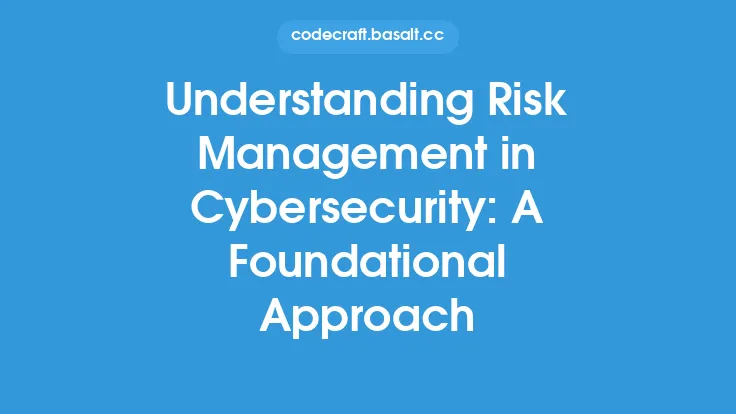In the realm of cybersecurity, identifying and prioritizing risks is a critical component of a comprehensive risk management strategy. As technology continues to evolve and cyber threats become increasingly sophisticated, organizations must be proactive in their approach to risk management. This involves not only identifying potential risks but also prioritizing them based on their likelihood and potential impact. In this article, we will delve into the best practices for identifying and prioritizing risks in cybersecurity, providing organizations with a solid foundation for protecting their assets and minimizing potential losses.
Introduction to Risk Identification
Risk identification is the process of determining what risks exist within an organization's systems, networks, and data. This involves a thorough analysis of the organization's assets, including hardware, software, and data, as well as the potential threats and vulnerabilities that could impact these assets. There are several techniques that can be used to identify risks, including risk assessments, vulnerability scans, and penetration testing. Risk assessments involve evaluating the organization's assets and identifying potential risks, while vulnerability scans and penetration testing involve simulating attacks on the organization's systems to identify weaknesses.
Prioritizing Risks
Once risks have been identified, they must be prioritized based on their likelihood and potential impact. This involves evaluating the potential consequences of each risk, including the potential financial loss, damage to reputation, and impact on operations. Risks can be prioritized using a variety of methods, including the National Institute of Standards and Technology (NIST) risk management framework, which provides a structured approach to risk management. The NIST framework involves categorizing risks based on their likelihood and potential impact, with high-risk items being prioritized for mitigation.
Risk Categorization
Risk categorization is the process of grouping risks into categories based on their likelihood and potential impact. This involves evaluating the potential consequences of each risk and assigning a risk score. The risk score can be used to prioritize risks, with high-risk items being addressed first. There are several risk categorization methods, including the NIST risk management framework, which provides a structured approach to risk categorization. The NIST framework involves categorizing risks into five categories: high, medium, low, very low, and negligible.
Risk Assessment Methodologies
There are several risk assessment methodologies that can be used to identify and prioritize risks, including qualitative and quantitative risk assessments. Qualitative risk assessments involve evaluating risks based on their likelihood and potential impact, while quantitative risk assessments involve assigning a numerical value to each risk. Quantitative risk assessments can be used to prioritize risks based on their potential financial impact, while qualitative risk assessments can be used to prioritize risks based on their potential impact on operations.
Threat Modeling
Threat modeling is the process of identifying and prioritizing potential threats to an organization's systems, networks, and data. This involves evaluating the potential attack vectors and identifying the most likely threats. Threat modeling can be used to prioritize risks based on their likelihood and potential impact, with high-risk items being addressed first. There are several threat modeling methodologies, including the STRIDE (Spoofing, Tampering, Repudiation, Information Disclosure, Denial of Service, and Elevation of Privilege) framework, which provides a structured approach to threat modeling.
Vulnerability Management
Vulnerability management is the process of identifying and prioritizing vulnerabilities in an organization's systems, networks, and data. This involves evaluating the potential vulnerabilities and identifying the most critical ones. Vulnerability management can be used to prioritize risks based on their likelihood and potential impact, with high-risk items being addressed first. There are several vulnerability management methodologies, including the Common Vulnerabilities and Exposures (CVE) framework, which provides a structured approach to vulnerability management.
Continuous Monitoring
Continuous monitoring is the process of continuously evaluating an organization's systems, networks, and data for potential risks and vulnerabilities. This involves using a variety of tools and techniques, including vulnerability scans, penetration testing, and risk assessments. Continuous monitoring can be used to identify and prioritize risks in real-time, allowing organizations to respond quickly to emerging threats.
Best Practices for Identifying and Prioritizing Risks
There are several best practices that organizations can follow to identify and prioritize risks, including:
- Conducting regular risk assessments to identify potential risks and vulnerabilities
- Using a structured approach to risk management, such as the NIST risk management framework
- Prioritizing risks based on their likelihood and potential impact
- Using threat modeling and vulnerability management to identify and prioritize potential threats and vulnerabilities
- Implementing continuous monitoring to identify and prioritize risks in real-time
- Providing training and awareness programs to educate employees on cybersecurity risks and best practices
Conclusion
Identifying and prioritizing risks is a critical component of a comprehensive risk management strategy. By following best practices, such as conducting regular risk assessments, using a structured approach to risk management, and prioritizing risks based on their likelihood and potential impact, organizations can protect their assets and minimize potential losses. Additionally, using threat modeling, vulnerability management, and continuous monitoring can help organizations identify and prioritize potential threats and vulnerabilities, allowing them to respond quickly to emerging threats. By taking a proactive approach to risk management, organizations can ensure the confidentiality, integrity, and availability of their systems, networks, and data.





